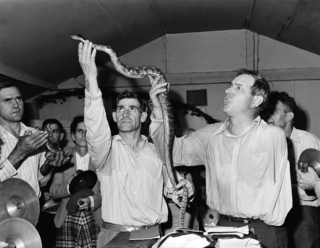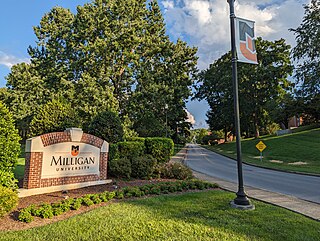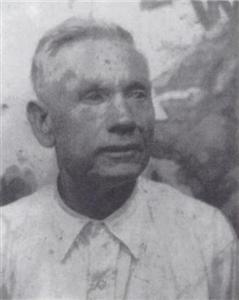Thomas G. Burton | |
|---|---|
| Born | January 7, 1935 |
| Nationality | American |
| Occupation(s) | Academic, Author |
Thomas G. Burton is an American academic and author with an interest in Appalachian folk culture. [1]
Thomas G. Burton | |
|---|---|
| Born | January 7, 1935 |
| Nationality | American |
| Occupation(s) | Academic, Author |
Thomas G. Burton is an American academic and author with an interest in Appalachian folk culture. [1]
Burton was born on January 7, 1935, in Memphis, Tennessee. His first degree was a Bachelor of Arts from David Lipscomb College in 1956. He then received a Master of Arts in 1958 and a PhD in 1966, both from Vanderbilt University.
He became a member of the Department of English of East Tennessee State University in 1958. He became a full professor in 1967, holding the position until he retired in 1995. He was appointed Professor Emeritus 1996.
Burton's book on snake handling, Taking up Serpents, was described as an authoritative study of the belief by National Geographic magazine. [2]
The serpent, or snake, is one of the oldest and most widespread mythological symbols. The word is derived from Latin serpens, a crawling animal or snake. Snakes have been associated with some of the oldest rituals known to humankind and represent dual expression of good and evil.

Snake handling, also called serpent handling, is a religious rite observed in a small number of isolated churches, mostly in the United States, usually characterized as rural and part of the Holiness movement. The practice began in the early 20th century in Appalachia and plays only a small part in the church service. Participants are Holiness, or Pentecostals. The beliefs and practices of the movement have been documented in several films and have been the impetus for a number of state laws related to the handling of venomous animals.

Appalachia is a geographic region located in the central and southern sections of the Appalachian Mountains of the eastern United States. Its boundaries stretch from the western Catskill Mountains of New York state into Pennsylvania, continuing on through the Blue Ridge Mountains and Great Smoky Mountains into northern Georgia, Alabama, and Mississippi, with West Virginia being the only state in which the entire state is within the boundaries of Appalachia. In 2021, the region was home to an estimated 26.3 million people, of whom roughly 80% were white.

Old-time music is a genre of North American folk music. It developed along with various North American folk dances, such as square dancing, clogging, and buck dancing. It is played on acoustic instruments, generally centering on a combination of fiddle and plucked string instruments, most often the banjo, guitar, and mandolin. Together, they form an ensemble called the string band, which has historically been the most common configuration to play old-time music. The genre is considered a precursor to modern country music.

Milligan University is a private Christian university in Milligan College, Tennessee. Founded in 1866 as the Buffalo Male and Female Institute, and known as Milligan College from 1881 to May 2020, the school has a student population of more than 1,300 students, most of whom reside and study on its 355-acre (1.44 km2) campus. Milligan University is historically related to the Restoration Movement. The university offers over 100 programs of study leading to both undergraduate and graduate degrees.

Bryan College is a private Christian college in Dayton, Tennessee. It was founded in the aftermath of the 1925 Scopes trial to establish an institution of higher education that would teach from a Christian worldview.

Raoul Weston La Barre (1911-1996) was an American anthropologist, best known for his work in ethnobotany, particularly with regard to Native-American religion, and for his application of psychiatric and psychoanalytic theories to ethnography.

Sand Mountain is a sandstone plateau in northeastern Alabama and northwestern Georgia and southeastern Tennessee where the plateau is known as Raccoon Mountain and Elder Mountain. It is part of the southern tip of the Appalachian mountain chain and it is the largest plateau in the chain. Geologically a continuation of Walden Ridge, Sand Mountain is part of the Cumberland Plateau, separated from the main portion of the plateau by the Tennessee River and Sequatchie Valley. The average elevation on Sand Mountain is around 1,500 feet (460 m) above sea level, compared to about 650 feet (200 m) in the surrounding area. This elevation leads to its having the coolest climate in the state of Alabama. The largest city on Sand Mountain is Albertville, in Marshall County. As of the 2020 census, the population of the city was 22,386.

Stephen Ronald Craig Hicks is a Canadian-American philosopher. He teaches at Rockford University, where he also directs the Center for Ethics and Entrepreneurship.

Yolande Cornelia "Nikki" Giovanni Jr. is an American poet, writer, commentator, activist, and educator. One of the world's most well-known African-American poets, her work includes poetry anthologies, poetry recordings, and nonfiction essays, and covers topics ranging from race and social issues to children's literature. She has won numerous awards, including the Langston Hughes Medal and the NAACP Image Award. She has been nominated for a Grammy Award for her poetry album, The Nikki Giovanni Poetry Collection. Additionally, she was named as one of Oprah Winfrey's 25 "Living Legends". Giovanni is a member of The Wintergreen Women Writers Collective

George Went Hensley was an American Pentecostal minister best known for popularizing the practice of snake handling. A native of rural Appalachia, Hensley experienced a religious conversion around 1910: on the basis of his interpretation of scripture, he came to believe that the New Testament commanded all Christians to handle venomous snakes.
The East Tennessee Historical Society (ETHS), headquartered in Knoxville, Tennessee, United States, is a non-profit organization dedicated to the study of East Tennessee history, the preservation of historically significant artifacts, and educating the citizens of Tennessee. The society operates a museum and museum shop in the East Tennessee History Center on Gay Street in downtown Knoxville. The East Tennessee Historical Society was established in 1834, 38 years after the establishment of the state of Tennessee, to record the history of the development and settlement of the area.
Our Southern Highlanders: A Narrative of Adventure in the Southern Appalachians and a Study of Life Among the Mountaineers is a book written by American author Horace Kephart (1862–1931), first published in 1913 and revised in 1922. Inspired by the years Kephart spent among the inhabitants of the remote Hazel Creek region of the Great Smoky Mountains, the book provides one of the earliest realistic portrayals of life in the rural Appalachian Mountains and one of the first serious analyses of Appalachian culture. While modern historians and writers have criticized Our Southern Highlanders for focusing too much on sensationalistic aspects of mountain culture, the book was an important departure from the previous century's local color writings and their negative distortions of mountain people.
Serpents are referred to in both the Hebrew Bible and the New Testament. The symbol of a serpent or snake played important roles in the religious traditions and cultural life of ancient Greece, Egypt, Mesopotamia, and Canaan. The serpent was a symbol of evil power and chaos from the underworld as well as a symbol of fertility, life, healing, and rebirth. The serpent, or snake is one of the oldest and most widespread mythological symbols. In some cultures snakes are a symbol of fertility. The serpent is a symbol of death is built into our unconscious minds. Serpents shedding their skin is a sign of new life. Serpents are represented as guardians of temples and sacred places. Serpent symbolism
Ralph Wilbur Hood Jr. is an American psychologist. He serves as Leroy A. Martin Distinguished Professor of Religious Studies at the University of Tennessee at Chattanooga, where he specializes in the psychology of religion.
Michael J. Hicks is the George & Frances Ball Distinguished Professor of Economics and director of the Center for Business and Economic Research and Professor of Economics at Ball State University.

William L. Lane was an American New Testament theologian and professor of biblical studies.
Gregory James Coots was a Pentecostal pastor in Kentucky who was featured in the National Geographic Channel reality television show Snake Salvation, which documented the lives of people who practice snake handling. He died from a rattlesnake bite during a service.
Jim Wayne Miller was an American poet and educator who had a major influence on literature in the Appalachian region.
{{cite web}}: CS1 maint: archived copy as title (link)